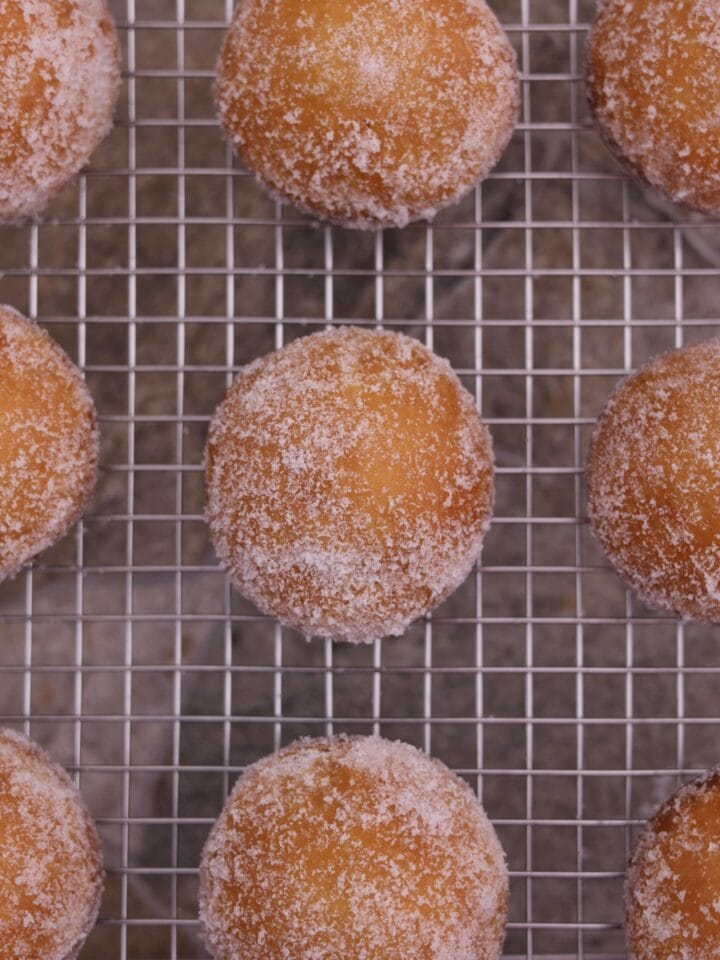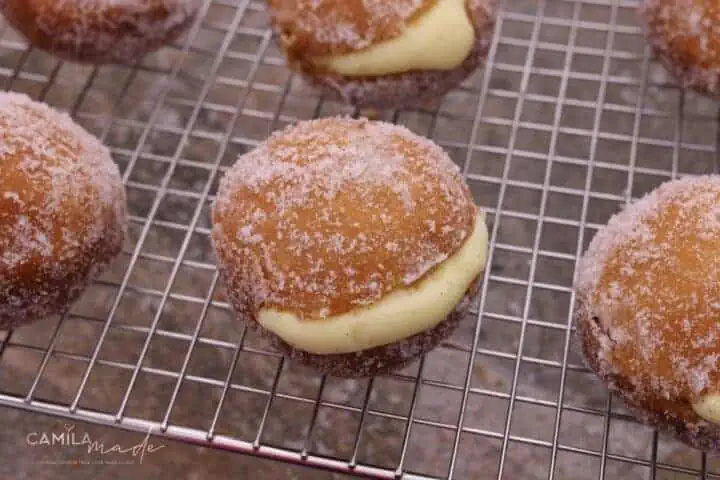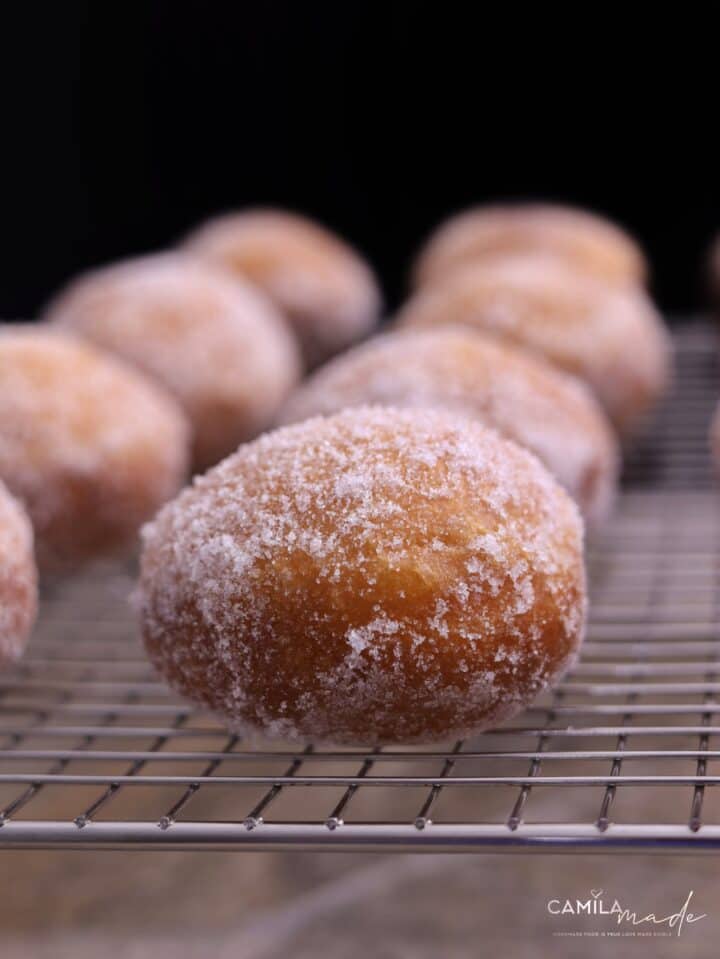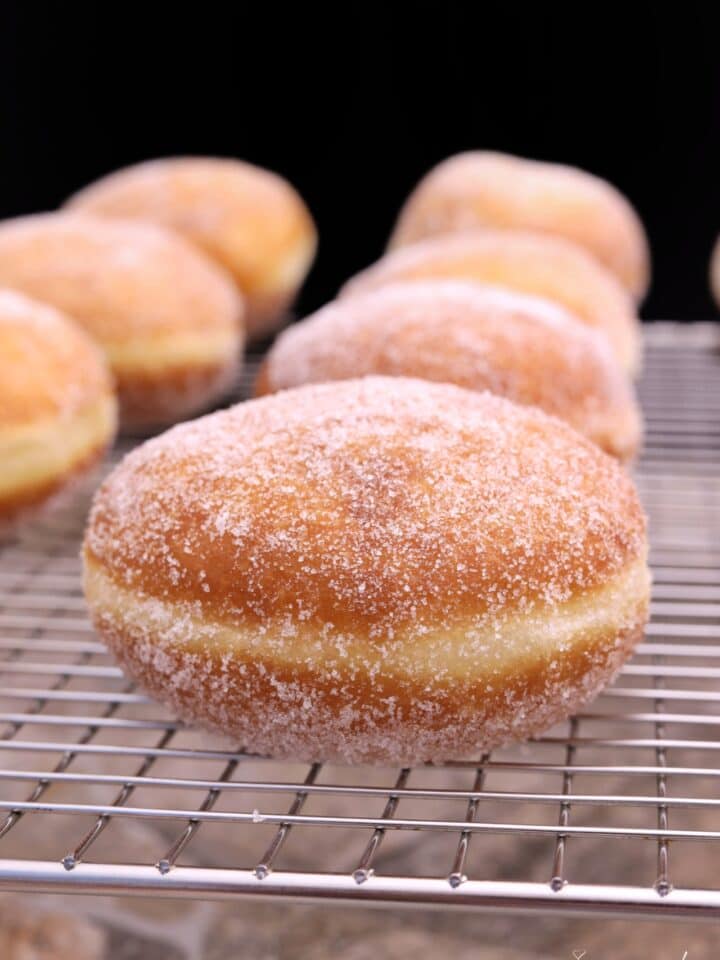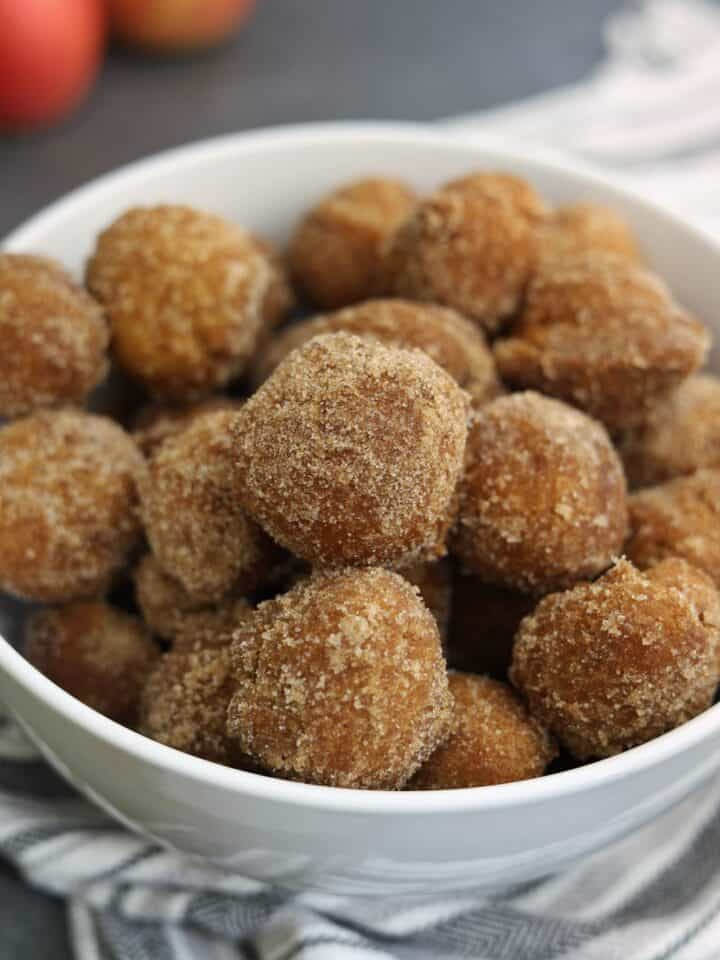When it comes to experimenting with bollos (Paraguayan-style doughnuts), my family and I are always up for the adventure. There's one that has truly taken hold of our hearts – The Classic Bollos Paraguayos.
Yet, there's another contender that has earned a special place as our second absolute favorite – the delectable variation of our classic recipe, the Orange Bollos.
This delightful twist offers a gentle, tender texture that's beautifully infused with the zesty essence of oranges. I've used my trusted Bollo Paraguayo dough to ensure the perfect foundation.
I can confidently say that this twist is a hit with my family, and I'm certain it'll be a hit with yours too.
Fill them with your favorite options like Crema Pastelera, Guava Preserve, Dulce de Leche, Chocolate Pastry Cream, or your favorite fruit preserves. Each bite will be a moment of pure delight, making your afternoon break extra special.
For more delicious recipes, try our Bollos Paraguayos, Crispy Orange Doughnuts, Bolinho de Chuva, and delightful Drop Doughnuts!😉😋🍩🍊
How to Make Bollos de Naranja
Note: The full instructions are provided in the recipe card below.
In a large bowl, combine the flour and yeast; set aside. This preliminary step helps to distribute the yeast in the dough evenly. In the stand mixer bowl, add the milk, butter, eggs, egg yolks, orange juice, salt, orange zest, and vanilla extract.
Mix with the dough hook attachment on low speed for 8 to 12 minutes. The dough should have very strong gluten development and be very tight but smooth. Mix to the intense stage of gluten development.
Lightly oil your hands and a large bowl. Place the dough in the bowl and knead it over itself until it forms a smooth ball. Ensure the entire surface of the dough is lightly covered with oil to prevent drying out.
Cover the bowl with cling film to create a seal and allow the dough to undergo bulk fermentation until it has nearly doubled in size, about 30 minutes. Gently fold the dough to further develop the gluten in the dough. Continue the fermentation process for another 30 minutes.
Line a sheet pan with parchment paper and grease the parchment paper. Divide the dough into 36 pieces (2 oz / 60g each) by hand. Shape each piece into a tight round and press lightly with the palm of your hand to flatten slightly.
Transfer, seam side down, to the prepared baking pan. Proof, covered, until the dough springs back slowly to the touch but does not collapse for 45 to 60 minutes.
Heat the oil in a heavy-duty pot to 350°F (175°C). Once the oil reaches the desired temperature, lightly grease a steel skimmer spoon.
Carefully transfer the proofed Bollos, a few at a time, seam side down, and fry, until golden brown on the first side, 1 minute. Turn and fry for another 1-½ minutes. Turn once more and fry until the top is deep golden brown, about 20 to 30 seconds.
Lift the Bollos from the hot oil, allowing the oil to drain away over the pot. Transfer to a paper towel-lined baking sheet to drain and cool slightly.
While still warm, gently toss in the sugar until both sides are well coated, place them side down on racks, and sift confectioners sugar over them once they are fully cooled.
Camila’s Tips: To test for intense gluten development, remove a piece of dough from the mixer, dip it in flour, and stretch it from underneath. If the dough stretches to form a thin membrane, allowing light to filter through, then the gluten has been properly and sufficiently developed. When the dough is overmixed, it will be sticky and wet and will have little or no elasticity. This occurs because the gluten strands have been broken down; the resulting will not rise properly.
If you want to fill your Bollos, fill a pastry bag with a small plain pastry tip and inject 1 oz/30g of Crema Pastelera, Chocolate Pastry Cream, dulce de leche, or your favorite fruit preserves into each bollo.
Next, gently toss the bollos in sugar until both sides are well coated. Place the coated bollos on cooling racks, ensuring they are arranged with the sugared side facing down. Once the bollos are fully cooled, sift the confectioners’ sugar over them.😋
Related Recipes:
Recipe
Easy Bollos de Naranja
Ingredients
- 1.02 kg (2lb 4 oz) bread flour
- 400 ml whole milk (110° to 115°F)
- 50 ml fresh orange juice at room temperature
- 30 g (1 oz) instant dry yeast
- 9 g (1-½ teaspoons) kosher salt
- 150 g granulated sugar
- 150 g unsalted butter or margarine softened
- 150 g (5-¼ oz / 3 large) eggs , room temperature
- 60 g (2 oz / 2 large) egg yolks , room temperature
- 15 ml Pure Vanilla Extract
- Zest from 2 oranges
Sugar Coating:
- 200 g granulated sugar
Instructions
- In a large bowl, combine the flour and yeast; set aside. This preliminary step helps to distribute the yeast in the dough evenly. In the stand mixer bowl, add the milk, butter, eggs, egg yolks, orange juice, salt, orange zest, and vanilla extract. Mix with the dough hook attachment on low speed for 8 to 12 minutes. The dough should have very strong gluten development and be very tight but smooth. Mix to the intense stage of gluten development.
- Lightly oil your hands and a large bowl. Place the dough in the bowl and knead it over itself until it forms a smooth ball. Ensure the entire surface of the dough is lightly covered with oil to prevent drying out. Cover the bowl with cling film to create a seal and allow the dough to undergo bulk fermentation until it has nearly doubled in size, about 30 minutes. Gently fold the dough to further develop the gluten in the dough. Continue the fermentation process for another 30 minutes.
- Line a sheet pan with parchment paper and grease the parchment paper. Divide the dough into 36 pieces (2 oz / 60g each) by hand. Shape each piece into a tight round and press lightly with the palm of your hand to flatten slightly. Transfer, seam side down, to the prepared baking pan. Proof, covered, until the dough springs back slowly to the touch but does not collapse for 45 to 60 minutes.
- Heat the oil in a heavy-duty pot to 350°F (175°C). Once the oil reaches the desired temperature, lightly grease a steel skimmer spoon. Carefully transfer the proofed Bollos, a few at a time, seam side down, and fry, until golden brown on the first side, 1 minute. Turn and fry for another 1-½ minutes. Turn once more and fry until the top is deep golden brown, about 20 to 30 seconds.
- Lift the Bollos from the hot oil, allowing the oil to drain away over the pot. Transfer to a paper towel-lined baking sheet to drain and cool slightly. While still warm, gently toss in the sugar until both sides are well coated, place them side down on racks, and sift confectioners sugar over them once they are fully cooled.
- Camila’s Tips: To test for intense gluten development, remove a piece of dough from the mixer, dip it in flour, and stretch it from underneath. If the dough stretches to form a thin membrane, allowing light to filter through, then the gluten has been properly and sufficiently developed. When the dough is overmixed, it will be sticky and wet and will have little or no elasticity. This occurs because the gluten strands have been broken down; the resulting will not rise properly.
- If you want to fill your Bollos, fill a pastry bag with a small plain pastry tip and inject 1 oz/30g of Crema Pastelera, Chocolate Pastry Cream, dulce de leche, or your favorite fruit preserves into each bollo. Next, gently toss the bollos in sugar until both sides are well coated. Place the coated bollos on cooling racks, ensuring they are arranged with the sugared side facing down. Once the bollos are fully cooled, sift the confectioners’ sugar over them.😋
Notes
All nutritional information is based on third-party calculations and is only an estimate. Each recipe and nutritional value will vary depending on the brands you use, measuring methods, and portion sizes per household.

